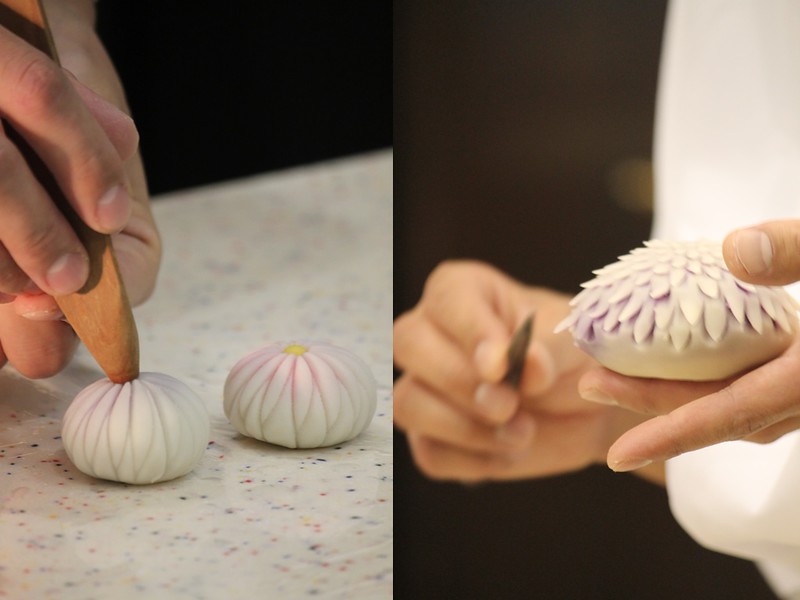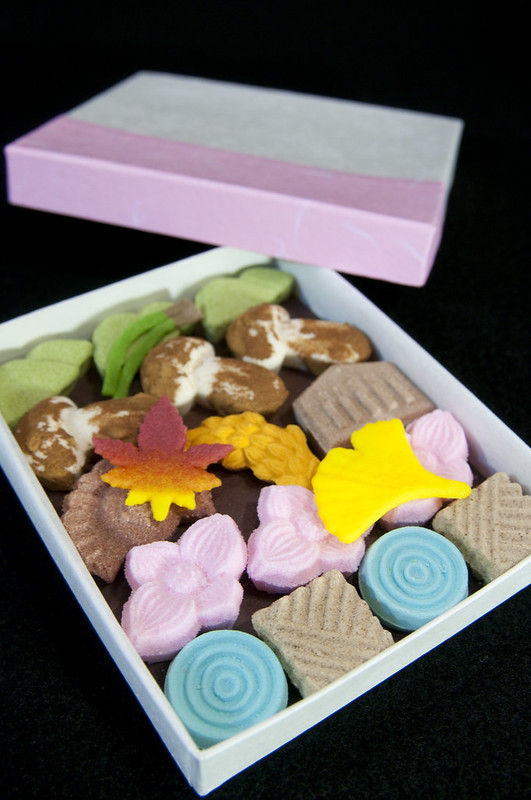Chado, The Japanese Way of Tea: a Celebration of Harmony, Tradition, and Imperfect Beauty
According to Sen no Rikyū, the "Japanese tea master who perfected the tea ceremony and raised it to the level of an art", Wa ("harmony among men and with Nature") is one of the guiding principles of the Japanese tea ceremony - known as either sadō/chadō (茶道, "the way of tea") or chanoyu (茶の湯,"hot water for tea”) - together with Kei ("respect and an attitude of gratitude towards all things"), Sei (purity, a "desireless freshnes of the heart"), and Jaku (tranquillity).
you will feel that all the dust of your mind is washed away.”
- Sen no Rikyū -
Kikugawa Eizan - Woman Performing the Tea Ceremony

Sense of Japan - Japanese Tea Ceremony from Naoki MIYASHITA/ Terminal81 Film on Vimeo
The Tea Ceremony (or teaism) - defined by Japanese scholar and art critic Okakura Kakuzō as "a cult founded on the adoration of the beautiful among the sordid facts of everyday existence" that "inculcates purity and harmony, the mystery of mutual charity, the romanticism of the social order. It is essentially a worship of the Imperfect, as it is a tender attempt to accomplish something possible in this impossible thing we know as life." [The Book of Tea] - isn't purely about serving and drinking tea: it's a spiritual experience that focusses on aesthetics, simplicity, seasonality (colors, designs, and flowers all reflect the time of the year).
The concept of Ichi-go ichi-e (一期一会) - commonly translated as "for this time only", and "once in a lifetime" - tends to be associated with tea ceremony, as this ritual does delicately capture the ephemeral beauty of passing time and stresses the importance of cherishing and appreciating every moment we live and every encounter we make. Feudal lord and tea ceremony practicioner Ii Naosuke is reported to have claimed that "Great attention should be given to a tea gathering, which we can speak of as 'one time, one meeting' (ichigo, ichie). Even though the host and guests may see each other often socially, one day's gathering can never be repeated exactly. Viewed this way, the meeting is indeed a once-in-a-lifetime occasion. The host, accordingly, must in true sincerity take the greatest care with every aspect of the gathering and devote himself entirely to ensuring that nothing is rough. The guests, for their part, must understand that the gathering cannot occur again and, appreciating how the host has flawlessly planned it, must also participate with true sincerity. This is what is meant by 'one time, one meeting'." [Rhetoric and Kairos: Essays in History, Theory, and Praxis].
Katsushika Hokusai - Teahouse at Koishikawa the morning after a snowfall

Image source: Library of Congress
Isoda Koryūsai - The Courtesan Karahama of Yamashiroya Performing the Tea Ceremony
 (Image source: The Cleveland Museum of Art)
(Image source: The Cleveland Museum of Art)
A tea ceremony can be either informal and relatively simple, or formal and elaborate: the former - chakai (茶会) - does usually involve thin tea and accompanying sweets, while the latter - known as chaji (茶事) - includes a meal, thick tea (koicha, 濃茶), thin tea (usucha, 薄茶), and traditional sweets (wagashi, 和菓子), offered to guests BEFORE tea is served to contrast the bitter taste of matcha.
Namagashi (生菓子) - the main sweets - are a variety of fresh, moist wagashi usually served during the thick tea ceremony. As explained by the Tokyo Restaurants Guide:
"Namagashi are meant to engage all five senses, so a lot of thought is given to their designs and names. In addition, each sweet skillfully makes an allusion to classical literature, history, cultural climate and/or seasonal changes.
・Taste: enjoy the deliciousness
・Smell: sense the aromas of the ingredients
・Touch: feel the texture, mouthfeel and the sensation of cutting the sweet with a kuromoji (black willow) pick.
・Sight: appreciate the appearance
・Hearing: hear the name [of the wagashi], consider its background and meaning"
 (Image source: Flickr - Author: Annabelle Orozco)
(Image source: Flickr - Author: Annabelle Orozco) (Image source: Flickr - Author: Yuichi Sakuraba)
(Image source: Flickr - Author: Yuichi Sakuraba) (Image source: Flickr - Author: Yuichi Sakuraba)
(Image source: Flickr - Author: Yuichi Sakuraba) (Image source: Flickr - Author: Yuichi Sakuraba)
(Image source: Flickr - Author: Yuichi Sakuraba) (Image source: Flickr - Author: Yuichi Sakuraba)
(Image source: Flickr - Author: Yuichi Sakuraba)Higashi (干菓子/乾菓子), on the other hand, are dry wagashi usually served during the thin tea ceremony:

(Image source: Flickr - Author: Yuichi Sakuraba)
- first volume;
- second volume;
- third volume;
Since wagashi are related to nature and to seasonality, many of them are named after waka poems, as highlighted in the following example (note about the poem: "The expression depicts the scenery of the four seasons, and resembles a beautiful river as a woven brocade."):

(Image and poem source: National Diet Library - Japanese Sweets Designs )
**************
Related articles:
Gift Giving Etiquette in The Confucian-Asia Cluster: The Luxury Fruit Culture
**************
TRAVEL RECOMMENDATIONS Attractions, Tours, Experiences: Paid/Live (PL), Paid/Virtual (PV) JAPAN - JAPAN RAIL PASS (P) - SIM Card with Internet (P) - Japanese Sweets: Mochi, Daifuku and Wagashi Class, Tokyo (PL) - Matcha Delight: Make Popular Japanese Desserts with Matcha,Tokyo (PL) - Experience the Tea Ceremony in Tokyo Ginza with a 30+ Years Experience Master, Tokyo (PL) - Make Your Own Matcha Tea in a Traditional Tea Ceremony, Kyoto (PL) - Matcha Tea Tour of Uji, Kyoto (PL) - Nishiki Market Food Tour, Kyoto (PL) - Japanese Calligraphy Class in Kimono, Kyoto (PL) UK JAPANESE TEA CEREMONY WORKSHOP, LONDON (PL) VIRTUAL - Tea Ceremony Experience Online by Maikoya, Virtual Tea Classes Available Daily (PV) - TEA CEREMONY VIRTUAL WORKSHOP (PV)
READING RECOMMENDATIONS: - Wagashi: Little Bites of Japanese Delights - Tokyo Cult Recipes - The Story of Japanese Tea: a broad outline of its cultivation, manufacturing, history and cultural values - The Book of Tea Hardcover – Illustrated - The Book of Tea (Kodansha Bilingual Books) (English and Japanese Edition) - A Bowl for a Coin: A Commodity History of Japanese Tea Hardcover – Illustrated - The Japanese Way of Tea: From Its Origins in China to Sen Rikyu - Chado the Way of Tea: A Japanese Tea Master's Almanac - Zen and Japanese Culture - The Cambridge Companion to Modern Japanese Culture - Wabi Sabi: The Wisdom in Imperfection SOURCES: - Bodart, B. (1977). "Tea and Counsel. The Political Role of Sen Rikyu". Monumenta Nipponica, 32(1), 49-74. doi:10.2307/2384071 - Britannica: Sen Rikyū [Online] - "CHANOYU: THE JAPANESE TEA CEREMONY". (1976). India International Centre Quarterly, 3(2), 159-161 - Wikipedia: Kikukawa Eizan [Online] - Kimono Tea Ceremony Maikoya Tea Ceremony in Japan [Online] - Tea Ceremony in Japan [Online] - Google Arts & Culture: Join the Tea Ceremony at the Ichijō Ekan Sansō [Online] - Britannica: Okakura Kakuzō [Online] - Chinese Buddhist Encyclopedia: Japanese Aesthetics, Wabi-Sabi, and the Tea Ceremony [Online] - Project Gutenberg: The Book of Tea by Okakura Kakuzō [Online] - NATURE X DESIGN: Ichi-Go Ichi-E: One Time, One Meeting - Deconstructing Chadō, the Japanese Tea Ceremony, to reveal the ephemerality of beauty [Online] - Sipiora, P., & Baumlin, J. (2012). "Rhetoric and Kairos: Essays in History, Theory, and Praxis". Albany, NY: SUNY Press - KATSUSHIKA HOKUSAI, THE COMPLETE WORKS: BIOGRAPHY OF KATSUSHIKA HOKUSAI [Online] - HONOLULU MUSEUM OF ART: Isoda Koryūsai [Online] - The Five College Center for East Asian Studies: Koicha Temae: Thick Tea Procedure [Online] - The Five College Center for East Asian Studies: Usucha Temae: Thin Tea Procedure [Online] - Tokyo Wagashi Association: About Wagashi [Online] - Tokyo Wagashi Association: The Wide World of Wagashi [Online] - TOKYO RESTAURANTS GUIDE: Wagashi: Traditional Japanese Confectionery that Delights the Senses [Online] - National Diet Library: History of Japanese Sweets, Introduction [Online] - National Astronomical Observatory of Japan (NAOJ): "24 Sekki" or 24 Solar Terms [Online] - National Diet Library: Japanese sweets designs [Online] - Tokyo Teacher: Tatsuta River Momiji Disturbed Flowing Meaning Grammar Part of Speech [Online] This post contains affiliate links: if you decided to buy any of the products listed here, I would earn a small commission (at no additional cost to you).

